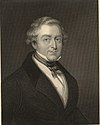George Murray (British Army officer)
The Viscount Goderich | |
|---|---|
| Personal details | |
| Born | 6 February 1772 Tory |
| Spouse |
Louisa Erskine
(m. 1825; died 1842) |
| Children | 1 |
Sir George Murray .
Background and education
Murray was born in
Military career
In 1789, Murray obtained a
He was briefly in Canada from December 1814 to May 1815 where he was appointed provisional
After the cessation of hostilities, Murray was based in France as Chief of Staff to the Army of Occupation and, thereafter, he was appointed
Political career
Murray was a
Other public appointments
Murray was also President of the
Personal life

Murray was married to Lady Louisa Erskine (née Paget) (1777-1842), widow of Lieutenant General Sir James Erskine (1772-1825), and sister of his fellow general, Henry, Lord Anglesey; the couple had one daughter, Louise Georgina. Murray died in July 1846, aged 74, and was buried in Kensal Green Cemetery, London. His substantial papers and maps were given to the National Library of Scotland by a great-niece in 1913.
Legacy
The Memorials to Governors in the Chapel of the present-day Royal Military Academy Sandhurst include: In Memory of General the Right Hon. Sir George Murray, G.C.B., G.C H., Colonel 1st Royal Regiment of Foot. Died 28 July 1846, aged 74. He served in Holland, Egypt, Syria, the West Indies, Denmark, and Sweden ; wsLS Q.M.G. in the Peninsula; Commander-in-Chief in Canada; Chief of the Staff of the Army of Occupation in France ; Commander of the Forces in Ireland, and twice Master-General of the Ordnance. He was Governor of this College from 1819 to 1824.[5]
The Murray River and Mount Murray in eastern Australia, the Murray River and Murray County in Western Australia, were named after him. Places in Hong Kong named after him include: Murray House, one of the oldest surviving public buildings in Hong Kong, Murray Building, Murray Road and the former Murray Barracks. The city of Perth, Western Australia was named in his honour after his parliamentary constituency Perthshire.[6]
References
- ^ a b c d e f g h i j Dictionary of Canadian Biography on-line
- ^ Bob Burnham: The British Army Against Napoleon, p259
- ^ "No. 19222". The London Gazette. 19 December 1834. p. 2285.
- ^ "No. 18614". The London Gazette. 25 September 1829. p. 1766.
- ^ Major Augustus F. Mockler-Ferryman F.R.G.S., F.Z.S. `Annals of Sandhurst : a chronicle of the Royal Military College from its foundation to the present day, with a sketch of the history of the Staff College` (London: William Heinemann, 1900)
- ISBN 0-521-36242-3.
- Who's Who of British Members of Parliament: Volume I 1832–1885, edited by M. Stenton (The Harvester Press 1976)
Further reading
- Harding-Edgar, John (2018). Next To Wellington: General Sir George Murray: The Story of a Scottish Soldier and Statesman, Wellington's Quartermaster General. Hellion & Company. ISBN 9781912390137.
External links
- Hansard 1803–2005: contributions in Parliament by Sir George Murray
- Sir George Murray at electricscotland.com


